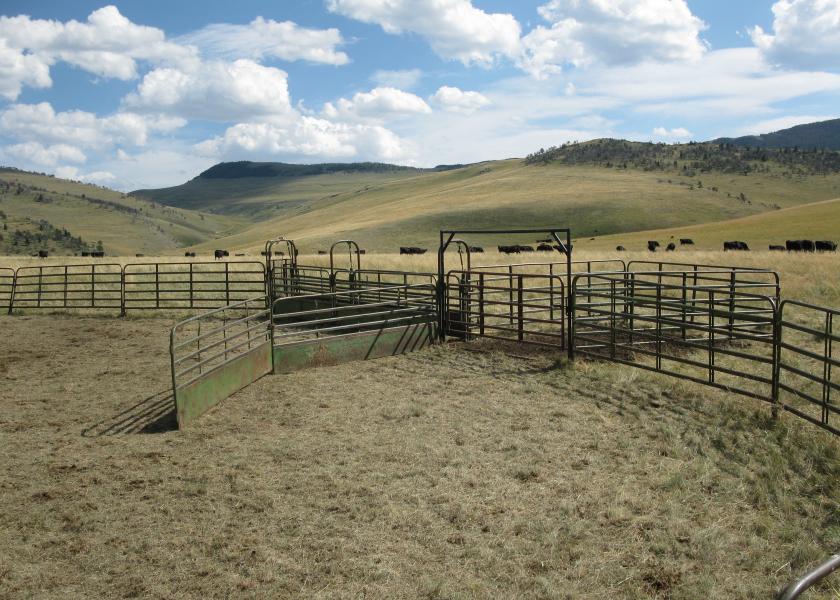Building a BudBox: Part Two

In a previous column, we discussed the principles, design and operation of the BudBox, a crowd pen developed by Bud Williams that makes our idea the animals’ idea so they willing do what we want, like go up the chute to the squeeze or truck.
Variations
Although the design is important, it is even more important to obey the principles and operation of the BudBox. Even atypically-shaped and sized BudBoxes can work well provided the operators obey the all-important principles and work them properly (see Drovers March 2020). As Bud Williams says, “If we want to do something with an animal, we’ve got to get it to want to do it also.” And that’s exactly what BudBoxes do.
BudBoxes can be designed with two exits for dual purposes (e.g., going to the squeeze chute in addition to the load out). However, BudBoxes used to load trucks need to be longer than the standard 14'x20' to accommodate more cattle (e.g., 28’ long), but still only 14' wide. “Any wider than that,” according to Bud, “and the handler will get out in the middle too far, and it won’t work as well.” (See Figure A, below.) The Xs denote handler position, and the arrows denote cattle flow.
With larger drafts (e.g., 20 900-lb. yearlings) the 20' mark cross gate is opened to make the box larger to
accommodate more cattle without over-crowding. A basic rule of operating a BudBox is to not fill it more than half full, otherwise it won’t work well.
Another variation is to build two BudBoxes end-to-end. Each exit can be used to feed either a line-chute to a squeeze, a trailer load out, a truck load out or a scale. (See Figure B, below.)


Retrofits
BudBoxes can be retrofitted easily in most applications in existing facilities. We have helped many outfits retrofit a BudBox that were having trouble getting cattle up the line-chute, or onto the scale, up the load out or onto the trailer. For example, Figure D, versions 1 and 2 below, shows a retrofit at our (W.H.) stocker operation from a V-shaped crowd pen to a modified BudBox (per Figure C above).


Historically, we (W.H.) had difficulty getting cattle onto the scale at our main ranch, so we retrofitted a BudBox on the outside of the existing alleyway (Figure E, below).

At a feedlot where I (D.H.) worked, we had considerable difficulty loading fat cattle out of the tub until we converted it to a BudBox by cutting out the back.
Field applications
Many outfits take portable corrals to the cattle (e.g., for branding, preconditioning, weaning). In any case, it’s easy and advantageous to incorporate a BudBox into the design, as in Figure F, below.

What to do when it doesn’t work?
Standing in the correct spot in a BudBox applies just enough pressure on the animals against the back of the box to get them to decide to turn around and go back where they came from. As they do, they simultaneously get to see the source of pressure, go around you, and see the opening — our BudBox principles —which they’ll usually readily go into. But what if they don’t? Or what if they won’t come out of the back of the box?
To get resistant animals out of the back of the box, it’s best to apply additional pressure directly ahead along the side of the box (see Figure G, below). As a cautionary note, however, you need to be very careful about getting too deep into the box because animals can, and often will, circle around behind you instead of going up the chute or through the opening.

If cattle hang up in either of the off-side corners (i.e., a or b), a viable technique is to pressure in and out at a 45° angle until they come out and by you.
If any animals show any resistance to going around you toward the entry to the chute, you can apply a little pressure directly into their sides.
Use of aids
When working a BudBox, as with everything we do with our livestock, we should think stockmanship first, and stockmanship is all about communication, not coercion. In conventional handling it’s about coercing animals to do what we want, usually with the help of aids (e.g., flags, paddles, prods, hot shots, crowd gates). In low-stress handling it’s about communicating with the animals through proper position. Therefore, there’s really no place or need for coercive aids.
Conclusion
With an understanding of the principles, design and operation of BudBoxes, plus a little imagination and creative thinking, almost any facility can be retrofitted with some type of BudBox to make cattle handling easier on the animals and on you.
Whit Hibbard is a fourth- generation Montana rancher and the editor of Stockmanship Journal. Dawn Hnatow manages two cattle ranches in Texas.
Related:







